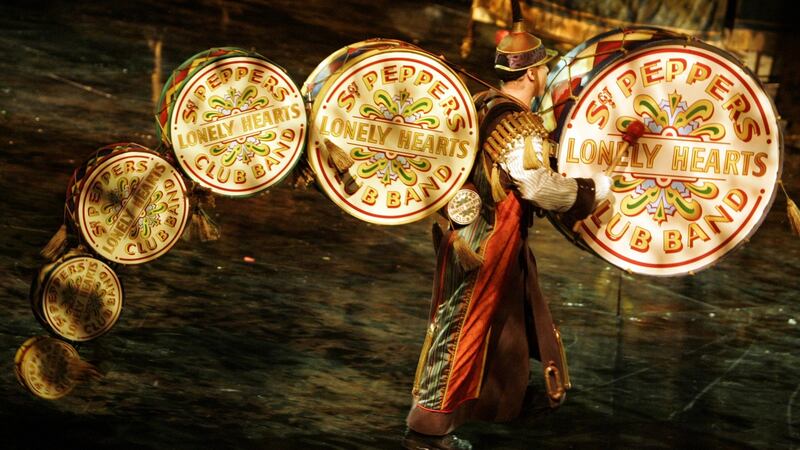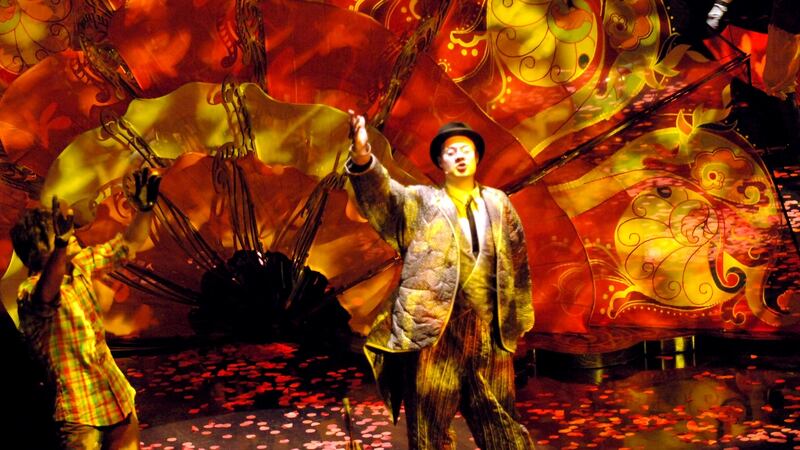When the window blinds in my Las Vegas hotel room roll upwards, the mechanism sighing softly with the effort, and I look south down the Strip towards the distant Martian landscape of Red Rock Canyon, The Beatles peek back at me.
In their musketeer moustaches and flower-power military frock coats, they huddle together on a 10-storey display at the top of the Mirage Hotel. It is that iconic image from the gatefold of Sgt Pepper's Lonely Hearts Club Band, but cropped and evened to show their faces in close alignment. It's hard to decide whether The Beatles look as if they own this city, or if Las Vegas has stacked their heads above its towers of fun and confection like giant Pez dispensers. Either way, The Beatles are performing here, nightly.

That may come as some surprise to fans, scholars and trivia buffs who know that The Beatles delivered their last live performance together in San Francisco, in 1966, and swore off the stage for good. “We’ve had enough of performing forever,” said John Lennon, at the end of four years of rigorous touring, unable to hear themselves over the screams of Beatlemaniacs. “I can’t imagine any reason which would make us do any sort of tour again.”
Instead they expanded their minds and took to Abbey Road Studios, where they enjoyed near-limitless resources and redefined the music album as an artwork. Strange, then, that the beginning of these “studio years” should result in a work that constantly presents itself, however archly, as a spontaneous performance – with band introductions, audience screams, applause, music hall motifs, encores and Albert Hall mentions – whose lyrics, energy and effects all communicate a sense of liveness. It’s a typically knowing contradiction: we have had enough of performing forever. We hope you will enjoy the show.
When word first started to circulate in 2000 that The Beatles were collaborating with Cirque du Soleil, the spectacular Montreal physical performance company, there were reasons to be sceptical. Following an exhaustive Anthology, and then a chart-conquering compilation album, 1, the suspicion was that Apple Corps was now engaged principally in reconciling differences between the rights holders in order to repackage The Beatles' back catalogue for new markets. After all, wasn't this just another jukebox musical?
Harrison’s idea
However, the show, Love, began as George Harrison's idea, not long before his death, in collaboration with Cirque du Soleil cofounder Guy Laliberté. Three years of negotiations followed between the surviving Beatles, Paul McCartney and Ringo Starr; Harrison's widow, Olivia Harrison; and John's widow, Yoko Ono. But a negotiation that mattered more took place between their producer, George Martin, his son Giles and the band's master tapes.
The real sensation is that of a live performance, where immortal songs sound freshly reconsidered
The received wisdom is that the Love soundtrack is something like an elegant mash-up, stripping the songs back to their components and reconfiguring them as though in a chatty conversation. Being For the Benefit of Mr Kite!, for instance, a song fittingly inspired by a 19th-century circus poster, here lurches into the hard stagger of the guitar line to I Want You (She's So Heavy) and the dive-bombing assaults of Helter Skelter – a pleasing pandemonium as an onstage carnival grows chaotic.
But the real sensation – aided by a purpose-built, 360-degree auditorium and a phenomenally complicated stage, all wrapped up in digital backdrops and given a perfectionist’s sound system – is that of a live performance, where immortal songs sound freshly reconsidered, musical ideas tumble together in something like free association, and the band appears to us either in surrogate figures or in iconic silhouette, to do what is still most wanted of them – to come together and play.
Three ambitions
The ambition of Love in performance – directed by the effervescently named Dominic Champagne, presumably no stranger to pop – is to make the music do three things. It provides a chronicle of the latter half of the 20th century, from the Blitz to the 1970s; it gives a veiled biography of The Beatles themselves, from individual temperaments to separate discoveries; and it sets the characters of their songs spinning throughout the space, as though John, Paul, Ringo and George were inseparable from Sgt Pepper, Lucy, Doctor Robert and a cluster of Nowhere Men.

It had its premiere in 2006 and was retooled last year for its 10th anniversary ("Brighter! Bolder! Bigger!"). It doesn't all work. The Beatles pushed every boundary they could find, but even the most skilled display of aerial theatre comes up against a strictly limited vocabulary. When Lucy in the Sky with Diamonds is performed as a sylph-like trapeze act high above a lake of dry ice, it feels as though John Lennon's euphoric hallucinations have been reduced to something like a family-friendly microdose.
Elsewhere, though, A Day in the Life conveys not just the chaotic darkening of a decade, but the death of Lennon himself, meeting its spiralling cacophony with a searing red glow. In a town where love seems like just another commodity in abundant supply, All You Need Is Love (which The Beatles debuted just weeks after the release of Sgt Pepper's), feels like a necessary salve; its coda here is interspersed with the group's ebullient studio chatter, jibing and joking in the immediate afterglow of creation.
Sit back and let the evening go, as you are commanded, and that is the closest many of us will ever get to seeing The Beatles in concert; reunited at last, live at the Mirage, and performing forever.












